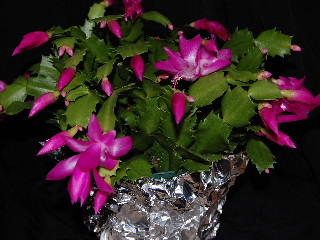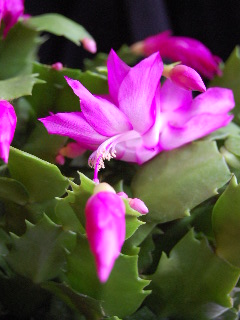
Although poinsettias are the most commonly sought-after plants of the Christmas holiday season, Christmas cactus (Zygocactus) comes in a close second.
They are available in blooms of several different colors ranging from pink to salmon to fuschia to white to various shades in between.
The Christmas cactus is not a true cactus at all, but is actually a tropical plant native to parts of Central and South America; note how the fully opened blossoms of the Christmas cactus closely resemble the blooms of one its tropical neighbors—the orchid.
In its natural setting, the Christmas cactus can often be found growing in the decayed leaves that have accumulated in the forked-crotch branches of large trees in the tropical forest. Conditions of filtered sunlight and abundant humidity provide the ideal environment in which the plants can thrive.
If you are a plant lover and you don’t have a Christmas cactus among the floral friends that surround you, get one. Better yet, get two—one for you and one to give as a gift during the holiday season. (Please read:
Mrs. Hamburger's Christmas Cactus.) This is certainly the time of year when the plants are readily available (usually with bloom buds in various stages of openness) at your local garden centers and retail stores. Give your Christmas cactus a brightly-lighted (but not direct sun) location of prominence in your household, so that you may observe the continued opening of the colorful blooms all through the holiday season.
Unless the air in your great indoors is extremely dry, you should only need to water your Christmas cactus about once a week. Remember, the plant is a succulent that stores moisture in its leaves and does not need its roots constantly soaked or soggy in order to grow well. Too much watering can, in fact, cause the dropping of bloom buds before they have a chance to blossom.
After all blooms have faded and fallen, allow the plant to rest for a month or two, giving only light waterings to keep the plant from completely drying out or shriveling and dropping leaves. As warm weather arrives, you should (if at all possible) move your Christmas cactus to an outdoor location where it can spend its summer vacation basking in the glow of filtered sunlight. Remember the plant’s tropical ancestry—filtered sun and ample humidity, but not water-logged roots—to assure your Christmas cactus a healthful summer season on its way back to the bountiful blooms of the December holidays.
Late spring/early summer is also a good time to re-pot your plant (using a good organic potting soil) if it has gotten too large for its container, although Christmas cactus does not seem to object too greatly to being root bound. You might also want to start some new little cacti from your original one as you do your re-potting. Do this by cutting off or pinching off the ends (at least 2 or 3 leaves per section) of some branches and placing them in small pots of moist sand or vermiculite until roots form on the tiny new plants.

As summer ends and cooler weather arrives, bring your Christmas cactus back indoors as the tropical expatriate cannot survive in frosty or freezing conditions. If you want to encourage another round of blooms for the coming Christmas holiday, begin about the middle of October to prepare your plant for the show.
Two factors are involved in bud formation—cool temperatures and extended periods of darkness. Coolness (about 50 to 55 degrees F) is necessary for a month to six weeks. The darkness of long nights (at least 12 hours per night) during this time is also necessary and can be produced by covering the plant with a blanket every night so no artificial light leaks in. Also, water very sparingly during this time. Bloom buds should begin forming by the middle to the end of November—just right to give you a grand showing of full blooms during Christmas!
On a personal note, my mother kept the same Christmas cactus all during the years of my childhood and for much of my adulthood. It was a huge plant that bore a profusion of brilliant blooms every single Christmas. She gave away many cuttings from this plant through the years as it continued to get larger and larger. The cactus grew “woody” at its base as it aged; it seemed to overflow its container, a cascading fountain of leaves and blossoms arching over and down the sides of the old clay pot.
The funny thing about this noble old unstoppable monster is that I don’t think my mother ever followed any of these rules of temperature and darkness in order to coax billions of blooms from this one wildly prolific Christmas cactus. She did, however, allow the plant to spend the summer outdoors, receiving the warm sunlight that filtered through the leaves of the maple trees. And she watered it on a regular basis and fed it a balanced plant food during its outdoor time. And, of course, she gave it lots of TLC.
As fall approached, she brought it indoors, sat it near the living room window, and watched as the buds began to form, buds that would explode into bouquets of blooms that would brighten the house during the Christmas holiday season.
You can do the same! Make friends with a Christmas cactus and enjoy its gift of blossoms every December.
 Although poinsettias are the most commonly sought-after plants of the Christmas holiday season, Christmas cactus (Zygocactus) comes in a close second.
Although poinsettias are the most commonly sought-after plants of the Christmas holiday season, Christmas cactus (Zygocactus) comes in a close second.
 As summer ends and cooler weather arrives, bring your Christmas cactus back indoors as the tropical expatriate cannot survive in frosty or freezing conditions. If you want to encourage another round of blooms for the coming Christmas holiday, begin about the middle of October to prepare your plant for the show.
As summer ends and cooler weather arrives, bring your Christmas cactus back indoors as the tropical expatriate cannot survive in frosty or freezing conditions. If you want to encourage another round of blooms for the coming Christmas holiday, begin about the middle of October to prepare your plant for the show.